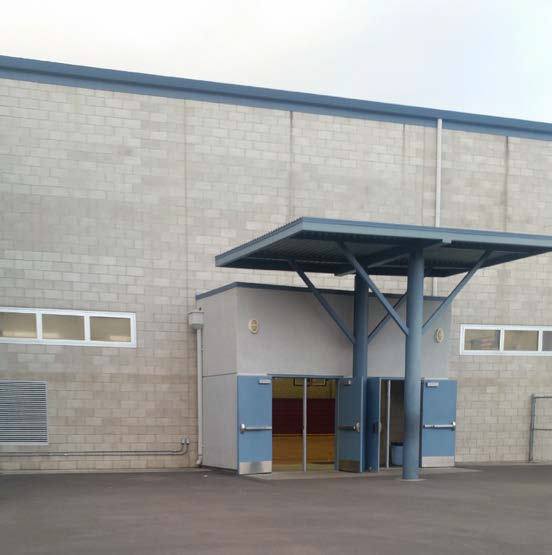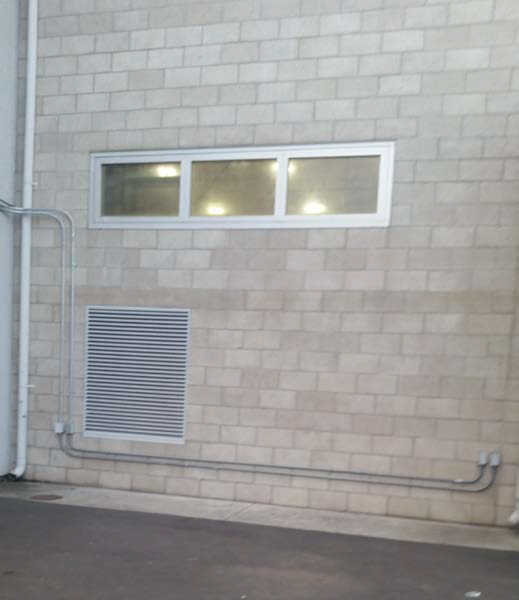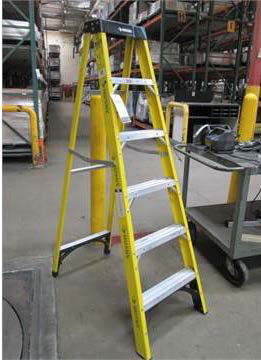Case Report: 16CA006
Custodian dies when he falls off a step ladder
Download a PDF to print this report:
Custodian dies when he falls off a step ladder (16CA006, PDF)
Summary
A 68-year-old custodian for a school district died from head injuries when he fell off a seven-foot step ladder while washing windows at a middle school gymnasium. The tops of the windows were approximately 15 feet from ground level. He was part of a three-man maintenance crew preparing the school grounds for the beginning of the school year. The fall was unwitnessed. A co-worker found the victim at the base of the ladder and called 911. There were no records available to indicate employees received specific training on procedures for best practices and required tools to use when cleaning windows. The CA/FACE investigator determined that, in order to prevent future incidents, employers of maintenance workers should:
- Ensure that the proper tools are available and used for jobs elevated above ground level.
- Ensure that employees receive documented training on procedures that incorporate best practices and tools used for specific tasks.
- Consider establishing a medical program to evaluate underlying health problems among workers who work on ladders.
Introduction
On Thursday, September 1, 2016, at approximately 8:30 p.m., a 68-year-old Hispanic male custodian died from head injuries when he fell off a seven-foot step ladder while washing windows. Notification of the incident was received on September 7, 2016, from the Cal/OSHA weekly update. On November 16, 2016, the CA/FACE investigator visited the incident site, interviewed representatives of the unified school district and co-workers of the victim, and took photographs of the incident scene. The investigator visited the incident scene again on January 26, 2017, along with Cal/OSHA compliance officers from the Santa Ana District office, to clarify unresolved issues within the investigation.
Employer
The employer of the victim was a unified school district that was established in 1966. The district included 32 schools and covered an area of approximately 59 square miles. The district enrolled over 22,000 students and had approximately 3,200 employees.
Written Safety Programs and Training
The school district had a written injury and illness prevention program (IIPP) that was designed to cover all 32 schools within the district. Documented training was offered for non-teaching employees (including custodians) in classroom settings on a yearly basis during the summer at different locations. Outside vendors usually taught the training. Safety meetings were held quarterly and attended by the district safety committee members who were then mandated to bring the information back to their schools. There was no documentation to indicate if tailgate training or safety meetings were held at the individual schools. There was no specific training provided to employees on how to clean a window or use ladders safely.
Worker Information
The victim in this incident was a 68-year-old Hispanic male who was born in Colombia and had been in the United States for 34 years. He had an eighth grade education and was bilingual in Spanish and English. He had worked for the school district for 26 years and had been at the school where the incident occurred for two years. His working hours, along with two other custodians, were Monday through Friday from 2:00 p.m. to 11:00 p.m.
Incident Scene
The scene of the incident was the exterior of a gymnasium for a middle school. The ground surface around the perimeter of the building was paved and level. The tops of the windows that were being cleaned in this incident were 15 feet above ground level, and the windows measured approximately 10 feet long by 3 feet high.
Investigation
On the day of the incident, the victim, along with two other co-workers, was preparing the school campus for the start of the new school year. After their lunch break, they reviewed the list of custodial tasks and the victim selected to wash and clean the windows in the gymnasium. According to employer representatives, there was a ten-foot ladder available on school grounds. The ladder used by the victim in this incident was a seven-foot step ladder that was in proper working order and met all safety and OSHA requirements (Exhibit 3). After obtaining this ladder, towel, and a spray bottle with window cleaning liquid from the supply room, the victim went to the outside of the gymnasium while a basketball game was underway.
The ladder was placed in an upright position outside of the building directly under the windows that required cleaning. The victim climbed the ladder and began spraying the windows with the cleaning agent and wiping them with the towel. One of the co-workers inside the gymnasium stated he saw the victim’s hand as he was wiping the windows from the outside. The other coworker was positioning trash containers outside the gymnasium approximately 25 yards behind the victim, and saw the victim lying down on the ground directly below the upright ladder. The fall was not witnessed. The co-worker saw the victim bleeding from his head and called 911. The paramedics arrived and transported the victim to a local hospital where he died from his injuries.
Contributing Factors
Occupational injuries and fatalities are often the result of one or more contributing factors or key events in a larger sequence of events that ultimately result in an injury or fatality. The CA/FACE team identified the following items as contributing factors in this incident that ultimately led to the fatality:
- Absence of alternative methods and tools to clean windows.
- Lack of specific training on safer methods to clean windows.
- Improper use of the ladder.
Cause of Death
According to the death certificate, the cause of death was blunt force injuries of head.
Recommendations
In order to prevent future incidents, employers of maintenance workers should:
Recommendation #1: Ensure that the proper methods and tools are available and used for jobs elevated above ground level.
Discussion: In this incident, the victim was washing windows that were elevated at the top 15 feet above the ground. As he was 5 feet 6 inches tall, the 7-foot ladder that he used would have raised his head height to approximately 10½ feet. With a 7-foot ladder, in order to reach the top of the window for cleaning, the victim likely stepped on the top rung of the ladder. This may have required a greater reach to clean the window, thereby leading to instability and the risk of falling. With a fall from this height, the victim was at high risk of a severe head injury. If the victim had used a 10- or 12-foot ladder, he would have been able to stand on a lower rung and reach the top of the window for cleaning. As an alternative to a taller ladder, there are extension tools that allow standing on the ground or a lower ladder level to clean windows. If the victim had used either a taller ladder or an extension tool, this incident may have been prevented.
Recommendation #2: Ensure that employees receive documented training on procedures that incorporate best practices and tools used for specific tasks.
Discussion: The victim in this incident did not receive specific training on window cleaning and the alternatives that would reduce the risk of falling from a height. The employer representatives stated that there was a 10-foot ladder available, but it is not known if the victim was aware of this, or had the training to identify the correct ladder or tool for the job. If the employer had provided task-specific training, the victim may have understood the risks of using a 7-foot ladder to clean a 15-foot high window, and been aware of best practices and alternative tools to use. If the victim used safer methods or tools, this incident may have been prevented.
Recommendation #3: Consider establishing a medical program to evaluate underlying health problems among workers who work on ladders.
Discussion: In this incident, the victim was a 68-year-old employee. Moncada and Mire (2017) found that workers older than 65 years are at greater risk of work-related deaths due to falls, slips, and trips than the overall worker population. Gait and balance problems are more common in older adults and are a major cause of falls in this population. Most changes in gait and balance that occur in older adults are related to underlying medical conditions.1
The use of multiple medications (four or more), as well as specific types of medications, can also lead to gait and balance problems and an increased rate of falls. While it is not known if the victim had underlying health problems that placed him at risk of falling, it is possible that he may have had more difficulty with gait and balance due to his age. Employers should consider implementing a medical evaluation program for employees who may be assigned to work on ladders. This should include assessment of the medical history and review of systems that may help reveal factors contributing to gait and balance disorders, current mobility status and functional level, focused physical examination, and observation of gait. Workers with a history of a fall should be evaluated with specific clinical tests for gait and balance. This type of medical program may help prevent the increased risk of falls with consequent serious and disabling injury, especially among older workers.
References
Moncada LV, Mire LG: Preventing Falls in Older Persons. Am Fam Physician. 2017; 96 (4):240- 247.
Subchapter 7. General Industry Safety Orders
Group 1. General Physical Conditions and Structures Orders
Article 4. Access, Work Space, and Work Areas
§3276. Portable Ladders.
Article 5. Window Cleaning
§3282. General Requirements for All Window Cleaning Operations.
§3287. Ladders.
Step Ladders vs Platform Ladders on the Jobsite - Cop Tool article
Exhibits

EXHIBIT #1. The incident scene.

EXHIBIT #2. The window the victim was washing when he fell.

EXHIBIT #3. A ladder similar to the one involved in the incident.
Authors
Hank Cierpich, FACE Investigator
Robert Harrison, MD, MPH, FACE Project Officer
Laura Styles, MPH, Research Scientist
1 Medical conditions may contribute to gait and balance disorders because of pain, shortness of breath, poor balance, loss of strength, decreased range of motion, poor posture, decreased sensory perception, fatigue, deformity, and decreased awareness of and ability to adapt to and move through possibly hazardous surroundings.
October 30, 2017